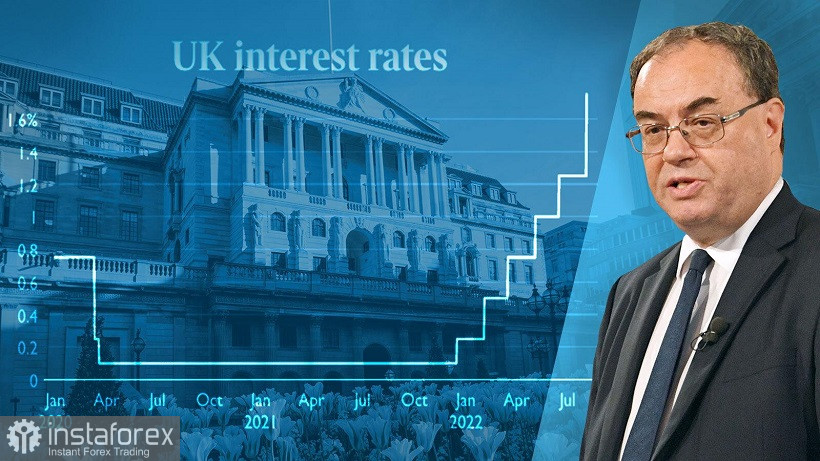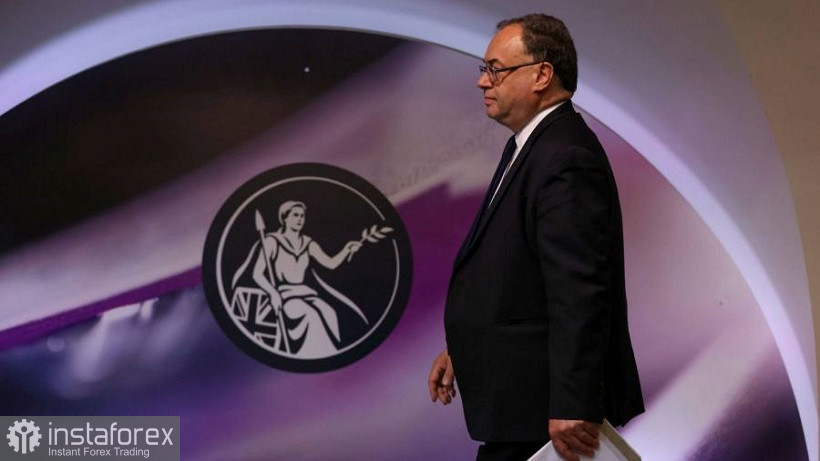After the announcement of the results of the August meeting of the Bank of England, the pound fell by more than 100 points against the dollar. And although the GBP/USD bears failed to impulsively develop a downward trend, the reaction itself is significant. Moreover, bearish moods still prevail for the pair, already following the press conference of BoE Governor Andrew Bailey. It is obvious that market participants reacted negatively not to the announced results of the August meeting (just as they coincided with the expectations of most experts), but to the rhetoric of the accompanying statement and the head of the central bank. However, first things first.

So, the BoE raised the discount rate by 50 basis points at once – from 1.25% to 1.75%, which was the sharpest rate increase since 1995. At the same time, the central bank announced disappointing macroeconomic forecasts. For example, the central bank predicted a recession of the British economy from the fourth quarter of this year. But inflation, on the contrary, is likely to be significantly ahead of the May forecast. According to updated estimates, the consumer price index in annual terms will jump from the current value of 9.4% to "more than 13%" in the 4th quarter of 2022. At the same time, inflation will remain "at a very high level" for most of 2023, before falling to the target value of 2% in approximately two years.
As mentioned above, the British currency reacted negatively to the results of the August meeting. The very fact of raising the rate by 50 points did not support the pound, as the central bank implemented the "basic", the most expected scenario. Recent macroeconomic releases have only increased the likelihood of this scenario. For example, in the second quarter, the UK economy unexpectedly showed growth (instead of the predicted decline). At the same time, inflation in the country has again updated the 40-year record, reaching the 9 percent mark. This combination of fundamental factors allowed us to assume that in August the central bank will definitely decide on a 50-point rate hike.
However, the future prospects do not look so clear. The macroeconomic forecasts announced today made traders think about the question: at what pace will the central bank be able to tighten monetary policy in a recession that will begin in the fourth quarter of this year and, according to the forecasts announced, will last 15 months?
Market participants quite reasonably doubted that the central bank would maintain the "sporty pace" of rate hikes, even despite the continued growth of inflation indicators. The central bank itself commented on the future prospects very vaguely, thereby increasing concern about this. The BoE said it would take "all necessary measures" to return inflation to the target two percent level in the medium term. At the same time, the central bank added a seemingly standard phrase, which, taking into account the upcoming recession, began to play with new colors: "The Central Bank Committee will determine the appropriate rate level based on estimates of the economic forecast and inflationary pressure by members of the Bank of England."

We can assume that the central bank will not increase the interest rate at an aggressive pace in the autumn and winter, and may even put the process of tightening monetary policy on pause after the September increase (another question arises here – by what amount?).
Thus, to date, inflation concerns have clearly "outweighed" the slowdown in economic growth: the British central bank has increased the rate for the sixth time (in the current cycle), and for the first time – in a 50-point step. But, according to a number of experts, this is the last such breakthrough: given the pessimistic forecasts, the central bank is likely to moderate its ardor in the autumn-winter period.
In other words, the English central bank has not become an ally of the British currency today, even despite a 50-point increase in the rate. Vague prospects and the threat of recession offset the hawkish decision of the central bank (also widely expected by the market). At the same time, the GBP/USD bears could not develop a downward movement, so it is not worth rushing with short positions. The "Golden Cross" signal is still valid on the D1 timeframe, which signals an increased probability of a trend change from the downside to the upside (the price is located between the middle and upper lines of the Bollinger Bands indicator, above the Tenkan-sen and Kijun-sen lines, which are located under the Kumo cloud). It is advisable to enter into short positions only when the pair overcomes the 1.2050 mark. In this case, the price will be between the middle and lower lines of the Bollinger Bands indicator, and the Ichimoku indicator will form a bearish Parade of Lines signal when all the indicator lines are located above the price. In this case, short positions with medium-term goals of 1.2000 and 1.1900 can be considered.





















